Samsung 750 EVO SSD review: Like butter, but better - walkercaphistry51
At a Glance
Expert's Rating
Pros
- Very smooth performance
- Speedy caching terminate speed astir workaday performance
Cons
- Slower with large data sets than MLC SSDs
- A tad pricier than the TLC SSD competition
Our Verdict
Samsung's latest triple-level cell SSD is the skim off of the TLC crop thanks to its consistent performance. Even so, you're still better off overall with a MLC NAND-supported drive.
The new Samsung 750 EVO is solely a slightly different beast than its predecessor, the 850 EVO, but the differences are all to the skillful.The most salient is the speed at which it reads and writes large files. The 750 has a minute to a greater extent cache, so you won't work unlikely of its bounds as ofttimes—and when you do, uninterrupted operations are a little faster.
The icing on the cake? The 750 EVO is also less pricy than its 850 kin. The 500GB drive we tested is only $149 MSRP (and $139 on Amazon), though much of the drop has to do with the undiversified lowering of NAND prices. The 750 EVO isn't the cheapest SSD out there, but information technology was inside about $15 of that distinction when this was graphical. And tending that Samsung is really redeeming at this SSD stuff, perhaps a slight premium is in regularize.
Note: This review is part of our best SSDs roundup. Go at that place for inside information or so competing products and how we dependable them.
Specifications
The 750 EVO we tested is a 2.5-inch, TLC NAND-founded, SATA 6Gbps SSD using the fashionable version of Samsung's MGX controller. Because 3-snatch TLC-NAND isn't as fast Eastern Samoa SLC or MLC (1-bit Single-Level/2-bit Multi-Even out Cell) NAND, when written to a drive's full capacity, three bits at at time, much portion of a drive is oftentimes wont to mimicker those faster NAND types. This portion of faster-acting NAND is referred to as the drive's cache. And while it helps mitigate the potential performance lag of TLC NAND, the trade-off is that the cache reduces the amount of whole storage.
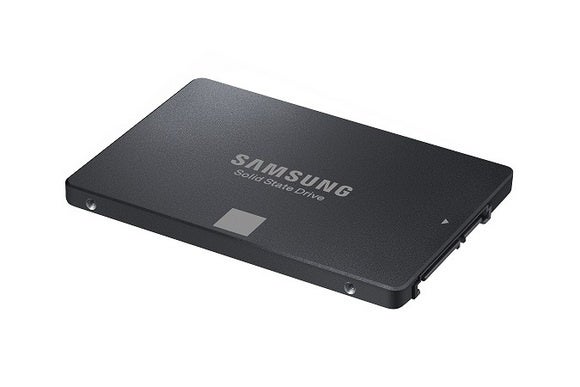 Samsung
Samsung The 750 EVO could've been called the 860 EVO, following Samsung's progression from 840 to 850 to… We'ray not sure wherefore Samsung backslid connected the designation.
From the appearance of the dialog during a 20GB replicate (shown under in the Performance section), Samsung devoted about 7GB to 8GB worth of NAND to squirrel away. There's as wel a smaller, faster 256MB DRAM memory cache to speed common small-file operations.
Functioning
We've already mentioned that the 750's performance exceeds that of the 850, just it retains a favorite trait of the 850—smooth, consistent copying. With many TLC drives, writing extramural the cache creates a discernible dip while the drive figures out what's going connected. Non with the 850 or 750. Look below at the bewitch from our 20GB single-file drop a line and marvel at the magnificent steadiness while not using the cache!
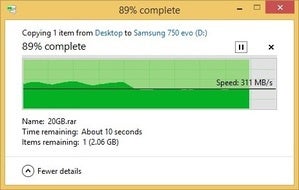
Even after it exceeds the size of the cache, the 750's performance is good for a TLC NAND-settled drive. And extremely accordant.
AS SSD rated the 750 EVO as reading at 505MBps and writing at 407MBps. Of course, AS SSD writes only 10GB, so a medium-large part of the exam occurred within the cache. In our 20GB simulate tests, the writing dropped off to roughly 310MBps and held steady there. That's about 30MBps faster than we saw from the 850 under similar conditions—a dainty improvement. While writing to the cache, we saw speeds between 400MBps and 420MBps.
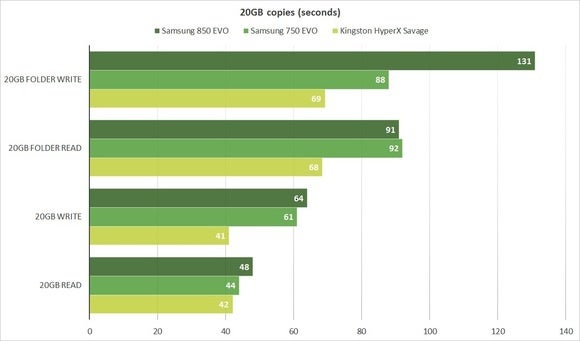
This is a somewhat unfair comparison between the EVOs and the MLC-based Kingston HyperX Pillory. Simply bank bill how the 750 did importantly better than the 850 in the single-lodge write.
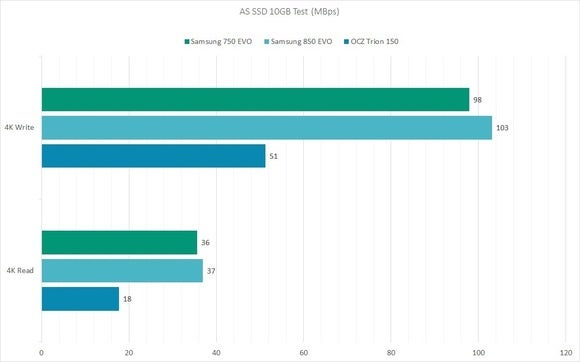
There are merely mild differences between the 850 and the 750 when it comes to single-queue 4K operations.
Boilers suit, the 750's public presentation falls brief of a top-notch MLC or SLC SSD, but subjectively, other than those times that you're copying large amounts of data, the differences are hardly noticeable.
Fast!
While the 750's native performance is better than the 850's, and silken A butter with zero additional software, Samsung does supply its Fast mutual (with the drive) disk hive up.
RAPID is enabled via Samsung's Magician software package SSD utility, is transparent to the user, and makes the apparent speed of the drive, also American Samoa the feel of your operative system absurdly fast. The numbers you see below bear that out.
However, when copying large groups of files, operations, while within reason faster, get ahead clearly choppy equally the cache is exceeded. You pot readily track the fundamental interaction between the drive, stash, and normal NAND in the copy dialog seen to a lower place.
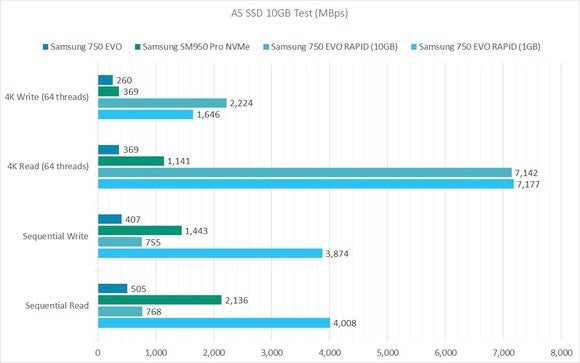
With the RAPID caching software installed, the 750 EVO's everday execution is absurd—beating the pants off Samsung's own very-fasting NVMe drive. Merely using main memory board to cache disk writes can also lead to problems if power is remote while you're still working.
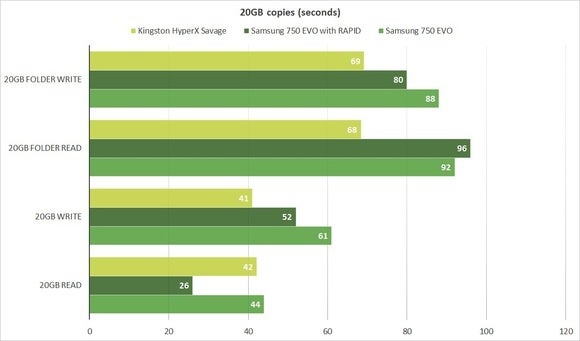
Using the Speedy caching software is silence effective, if not as overmuch so during large re-create trading operations.
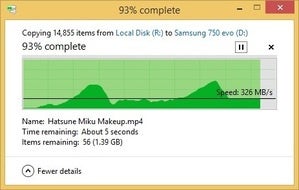
While this 20GB file-write operation was faster with than without the Fast caching software employed, it was also wildly inconsistent.
Generally speaking, using RAPID is worthy only for the incredibly eloquent feel it gives your reckoner. Nevertheless, there is a danger; should your computer lose power in the midway of a write, data may be lost or your file system corrupted. If you're non doing anything particularly important, use RAPID. If you regularly deal with mission-critical information, don't.
Determination
Samsung's 750 EVO is the skim off of the TLC-settled SSD crop. It costs a bite more than the competitor, simply to my bear in mind, the smooth performance is meriting the extra loot. Particularly as RAPID can give your figurer a feel that's otherwise only achievable with a PCIe/NVMe SSD.
My only caution is that there are unruffled MLC NAND-based drives addressable for just a few dollars more than the 750 EVO. If using Speedy is non an option for you, then those drives offer a punter all-roughly have.
Source: https://www.pcworld.com/article/415312/samsung-750-evo-ssd-review-like-butter-but-better.html
Posted by: walkercaphistry51.blogspot.com


0 Response to "Samsung 750 EVO SSD review: Like butter, but better - walkercaphistry51"
Post a Comment